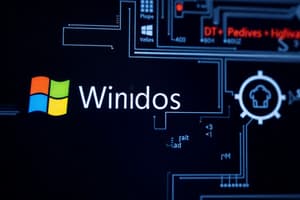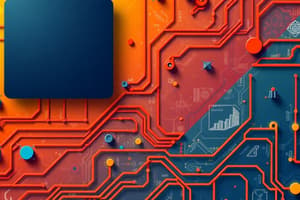Podcast
Questions and Answers
What is the main function of an Operating System (OS)?
What is the main function of an Operating System (OS)?
- Interacting with users through codes to simplify the computing experience
- Managing computer hardware and providing a basis for application programs (correct)
- Allocating resources efficiently in a computer system
- Executing specific tasks for users, such as word processing and web browsing
Which of the following is an example of System Software?
Which of the following is an example of System Software?
- Web Browser
- Word Processor
- Operating System (OS) (correct)
- Text Editor
What are examples of widely used Operating Systems?
What are examples of widely used Operating Systems?
- Google Chrome, Mozilla Firefox, Safari, Opera
- Python, Java, C++
- Windows, Linux, Ubuntu, macOS, iOS, Android (correct)
- Microsoft Word, Excel, PowerPoint
What is the purpose of I/O devices in a computer system?
What is the purpose of I/O devices in a computer system?
Which type of operating system allocates resources efficiently in a network environment?
Which type of operating system allocates resources efficiently in a network environment?
How does an Operating System provide a seamless computing experience?
How does an Operating System provide a seamless computing experience?
Flashcards are hidden until you start studying
Study Notes
- Operating System (OS) is a program that manages computer hardware and provides a basis for application programs
- OS acts as an intermediary between computer users and computer hardware
- Examples of widely used Operating Systems include Windows, Linux, Ubuntu, macOS, iOS, and Android
- Computer hardware includes CPU, memory, I/O devices, and resources
- I/O devices include input devices (keyboard, mouse, microphone) and output devices (monitor, speakers)
- System Software and Application Software exist in a computer system
- System Software commands or modifies computer hardware, with OS being a type of system software
- Application Software performs specific tasks for users, such as word processors, spreadsheets, compilers, text editors, and web browsers
- Users interact with software and hardware through codes; an OS simplifies this interaction
- An OS provides a seamless and easy computing experience by managing computer hardware and acting as an intermediary between users and hardware.- The text discusses types of operating systems and their functions, as well as the goals of an operating system.
- Types of operating systems include: batch, time-sharing, distributed, network, real-time, multi-programming/multi-processing, and multi-tasking.
- Operating systems act as an interface between users and hardware, allocating resources efficiently.
- Functions of the operating system include managing memory, ensuring security, and managing input/output devices.
- Goals of the operating system are to provide convenience and efficiency.
- Convenience is achieved by making it easy for users to communicate with hardware, while efficiency is achieved by managing resources effectively.
- Most operating systems aim for both convenience and efficiency.
- The text provides an introduction to operating systems, with more detailed study to follow in the lecture series.
Studying That Suits You
Use AI to generate personalized quizzes and flashcards to suit your learning preferences.





